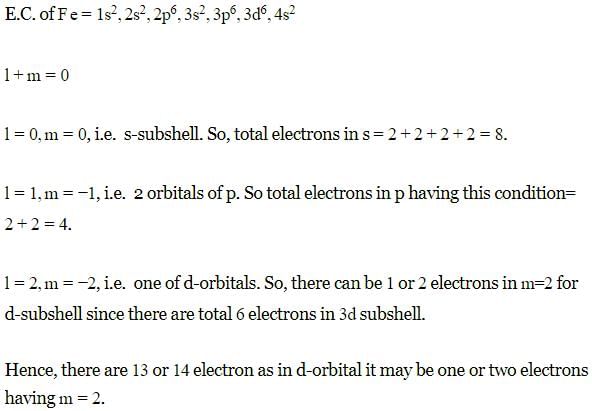Class 11 Exam > Class 11 Questions > Number of electrons having l + m value equal ...
Start Learning for Free
Number of electrons having l + m value equal to zero in 26Fe may be
- a)Both B and C
- b)14
- c)13
- d)12
Correct answer is option 'A'. Can you explain this answer?
Most Upvoted Answer
Number of electrons having l + m value equal to zero in 26Fe may bea)B...

Free Test
FREE
| Start Free Test |
Community Answer
Number of electrons having l + m value equal to zero in 26Fe may bea)B...
To find the number of electrons having l m value equal to zero in 26Fe, we need to understand the electronic configuration of iron (Fe).
Electronic configuration of Iron (Fe)
Iron (Fe) has an atomic number of 26, which means it has 26 electrons. The electronic configuration of Fe is:
1s2 2s2 2p6 3s2 3p6 4s2 3d6
Here, the last orbital, i.e., the 3d orbital, has six electrons.
Number of electrons having l m value equal to zero in 26Fe
The value of l determines the shape of the orbital, and the value of m determines the orientation of the orbital in space. For l=0, there is only one possible value of m, which is also zero. This means that an electron in an l=0 orbital has no preferred direction in space.
In the electronic configuration of Fe, the 4s and 3d orbitals are partially filled. Since the value of l for the 4s orbital is zero, there are 2 electrons in the 4s orbital with l=0 and m=0.
For the 3d orbital, there are 5 different orbitals: dxy, dyz, dxz, dx2-y2, and dz2. Each orbital can hold a maximum of 2 electrons, and since there are 6 electrons in the 3d orbital, one of the orbitals must have 2 electrons, and the other 4 orbitals must have 1 electron each.
Now, for the dxy, dyz, and dxz orbitals, the value of l is 2, which means there are no electrons with l=0 in these orbitals.
For the dx2-y2 and dz2 orbitals, the value of l is 2 and the value of m can be either +2, +1, 0, -1, or -2. This means that there are two electrons in the 3d orbital with l=0 and m=0, since the dx2-y2 and dz2 orbitals have this value.
Therefore, the total number of electrons in Fe with l=0 is 2+2=4.
However, the question specifically asks for the number of electrons with l m value equal to zero. This means that only the 4s electrons count, since they have l=0 and m=0. Therefore, the number of electrons in Fe with l m value equal to zero is 2.
Hence, the correct answer is option 'A' (13).
Electronic configuration of Iron (Fe)
Iron (Fe) has an atomic number of 26, which means it has 26 electrons. The electronic configuration of Fe is:
1s2 2s2 2p6 3s2 3p6 4s2 3d6
Here, the last orbital, i.e., the 3d orbital, has six electrons.
Number of electrons having l m value equal to zero in 26Fe
The value of l determines the shape of the orbital, and the value of m determines the orientation of the orbital in space. For l=0, there is only one possible value of m, which is also zero. This means that an electron in an l=0 orbital has no preferred direction in space.
In the electronic configuration of Fe, the 4s and 3d orbitals are partially filled. Since the value of l for the 4s orbital is zero, there are 2 electrons in the 4s orbital with l=0 and m=0.
For the 3d orbital, there are 5 different orbitals: dxy, dyz, dxz, dx2-y2, and dz2. Each orbital can hold a maximum of 2 electrons, and since there are 6 electrons in the 3d orbital, one of the orbitals must have 2 electrons, and the other 4 orbitals must have 1 electron each.
Now, for the dxy, dyz, and dxz orbitals, the value of l is 2, which means there are no electrons with l=0 in these orbitals.
For the dx2-y2 and dz2 orbitals, the value of l is 2 and the value of m can be either +2, +1, 0, -1, or -2. This means that there are two electrons in the 3d orbital with l=0 and m=0, since the dx2-y2 and dz2 orbitals have this value.
Therefore, the total number of electrons in Fe with l=0 is 2+2=4.
However, the question specifically asks for the number of electrons with l m value equal to zero. This means that only the 4s electrons count, since they have l=0 and m=0. Therefore, the number of electrons in Fe with l m value equal to zero is 2.
Hence, the correct answer is option 'A' (13).

|
Explore Courses for Class 11 exam
|

|
Question Description
Number of electrons having l + m value equal to zero in 26Fe may bea)Both B and C b)14c)13 d)12Correct answer is option 'A'. Can you explain this answer? for Class 11 2025 is part of Class 11 preparation. The Question and answers have been prepared according to the Class 11 exam syllabus. Information about Number of electrons having l + m value equal to zero in 26Fe may bea)Both B and C b)14c)13 d)12Correct answer is option 'A'. Can you explain this answer? covers all topics & solutions for Class 11 2025 Exam. Find important definitions, questions, meanings, examples, exercises and tests below for Number of electrons having l + m value equal to zero in 26Fe may bea)Both B and C b)14c)13 d)12Correct answer is option 'A'. Can you explain this answer?.
Number of electrons having l + m value equal to zero in 26Fe may bea)Both B and C b)14c)13 d)12Correct answer is option 'A'. Can you explain this answer? for Class 11 2025 is part of Class 11 preparation. The Question and answers have been prepared according to the Class 11 exam syllabus. Information about Number of electrons having l + m value equal to zero in 26Fe may bea)Both B and C b)14c)13 d)12Correct answer is option 'A'. Can you explain this answer? covers all topics & solutions for Class 11 2025 Exam. Find important definitions, questions, meanings, examples, exercises and tests below for Number of electrons having l + m value equal to zero in 26Fe may bea)Both B and C b)14c)13 d)12Correct answer is option 'A'. Can you explain this answer?.
Solutions for Number of electrons having l + m value equal to zero in 26Fe may bea)Both B and C b)14c)13 d)12Correct answer is option 'A'. Can you explain this answer? in English & in Hindi are available as part of our courses for Class 11.
Download more important topics, notes, lectures and mock test series for Class 11 Exam by signing up for free.
Here you can find the meaning of Number of electrons having l + m value equal to zero in 26Fe may bea)Both B and C b)14c)13 d)12Correct answer is option 'A'. Can you explain this answer? defined & explained in the simplest way possible. Besides giving the explanation of
Number of electrons having l + m value equal to zero in 26Fe may bea)Both B and C b)14c)13 d)12Correct answer is option 'A'. Can you explain this answer?, a detailed solution for Number of electrons having l + m value equal to zero in 26Fe may bea)Both B and C b)14c)13 d)12Correct answer is option 'A'. Can you explain this answer? has been provided alongside types of Number of electrons having l + m value equal to zero in 26Fe may bea)Both B and C b)14c)13 d)12Correct answer is option 'A'. Can you explain this answer? theory, EduRev gives you an
ample number of questions to practice Number of electrons having l + m value equal to zero in 26Fe may bea)Both B and C b)14c)13 d)12Correct answer is option 'A'. Can you explain this answer? tests, examples and also practice Class 11 tests.

|
Explore Courses for Class 11 exam
|

|
Signup for Free!
Signup to see your scores go up within 7 days! Learn & Practice with 1000+ FREE Notes, Videos & Tests.
























